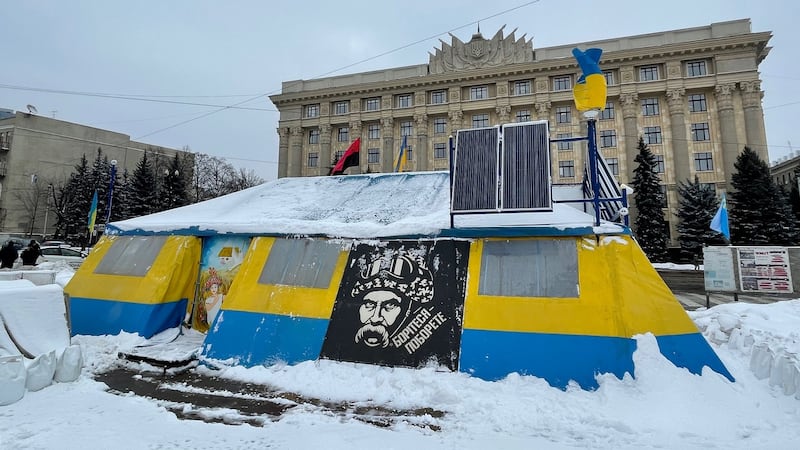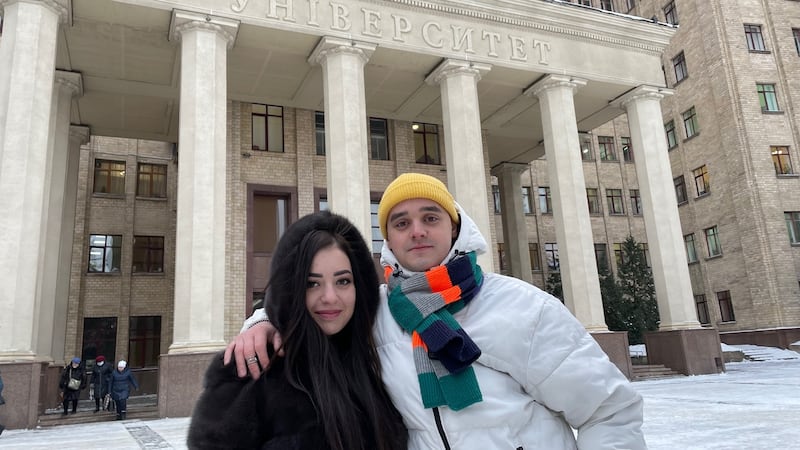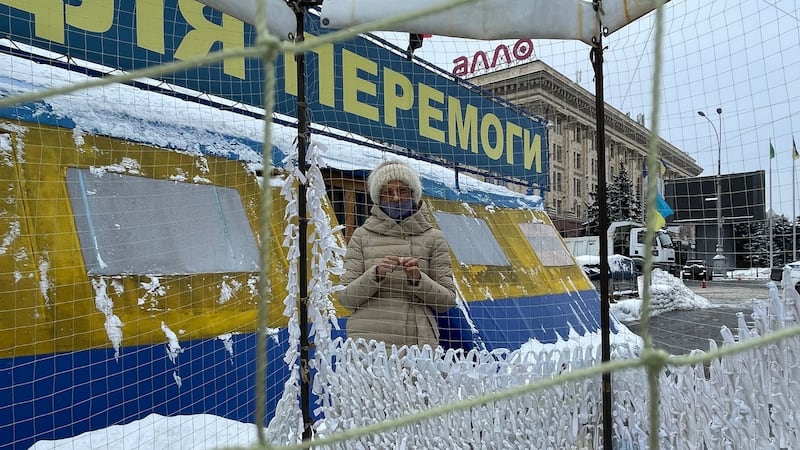It is well below zero on Freedom Square in Kharkiv, as Olha Volkova crouches in a biting wind and methodically ties strips of white cloth to a net that will soon camouflage Ukrainian soldiers on a snowy frontline 300km away.
Behind her, workers dismantle Christmas decorations and skaters twirl to festive music on a temporary ice rink; Ukraine's second city is peaceful and calm, even as fears grow of potential trouble coming not from the divided Donbas region – a conflict zone since 2014 – but directly from Russia, just 35km to the east of here.
The rumble around Ukraine is growing to a roar, as new video and photos emerge each day of troops and armour moving through Russia towards its neighbour, and the US and Europe urge the Kremlin to think again before launching an invasion that Britain warns would lead to "a terrible quagmire and loss of life".
But there is no panic in Kharkiv or other Ukrainian cities, which are now in the eye of what western leaders and intelligence reports depict as a gathering storm.
“Many people might already be at such a level of tension that it can’t go any higher,” Volkova says of her nation’s apparent stoicism in the face of the rising threat.
“Others try somehow to distance themselves from the situation and concentrate on work and family,” she explains, while admitting that she is fighting her own growing sense of dread.
“I do feel it is becoming more dangerous now, and I am really worried and scared,” says Volkova, who teaches Ukrainian and English in Kharkiv.
“But we don’t have a bag ready to escape quickly if necessary, or anything like that. If something really bad happens I guess we will have to go the army or connect with the territorial defence troops or join some other form of defence to help with opposition and resistance.”
Separatist army
Thousands of civilians now train with territorial units that were established across Ukraine as part of its “whole-of-society” approach to defence, in response to Russia’s capture of Crimea in 2014 and its creation of a separatist army that seized parts of Donbas in fighting that has ravaged the region and taken 14,000 lives.
The system taps into the powerful spirit of volunteerism that helped Ukraine survive a multi-faceted Russian attack eight years ago, when the country of 41 million was reeling from a revolution against its Kremlin-backed leaders of the time.

Volunteers raised funds, gathered supplies and made and bought equipment for Ukraine’s military, which was bolstered by thousands of people who put their lives on hold to serve as fighters and medics – many of whom went to the frontline direct from the epicentre of the revolution on Kyiv’s Maidan square.
Many were killed and wounded in some of the fiercest battles of the war, and their units are credited with helping restrict the Russian-led militia to parts of Donbas and keeping them out of neighbouring regions such as Kharkiv.
"If we didn't have volunteer battalions that went straight from Maidan to Donbas ... then Russia could have captured all of the east and south of Ukraine," says Ihor Volkov, Olha's husband.
“Now we are at the high point of the territorial defence service after several years of development,” adds the philosophy teacher, who served in a Kharkiv unit of the volunteer service until health reasons forced him to step back.
“If Russia comes here there will be great unrest and a lot of people will join the movement of national resistance, and the price of this aggression will be absolutely unacceptable [for Moscow].”
However, Volkov suspects Russia's major military moves of recent weeks -– sending 100,000 soldiers and convoys of armour towards Ukraine and other forces into Belarus for joint war games – could well be a distraction from Moscow's real intentions and a means of piling psychological pressure on cities like Kharkiv.
“I think all the movements we see now are a performance, and if Russia attacks it will be in an unexpected way,” he says. “If we want peace, we must be ready for war all the time ... It is illogical to think for one or two weeks that Russia will attack and then to decide that it won’t attack,” he adds.
“And when the media all the time repeats that an attack is coming, then it demoralises people – this can be another form of technology used by Russia in the information war.”
Sense of alarm
Kyiv has often craved more attention and support from its allies, but now – as the US warns that Russia could attack at “very short notice” and is recruiting pro-Moscow Ukrainian politicians to form a possible occupation government – finds itself in the odd position of tamping down the West’s spiralling sense of alarm.
"Did the invasion not start in 2014? Has the threat of war only appeared now?" Ukrainian president Volodymyr Zelenskiy said in a televised address this week.
“Take a deep breath. Calm down. Don’t run for buckwheat and matches ... Keep your head calm and cool, remain confident in your strength, in your army, in our Ukraine,” he told the nation.
In a subsequent interview with the Washington Post, however, he specifically raised the possibility of a Russian attack on Kharkiv.
“I will say realistically if Russia decides to enhance their escalation, of course they are going to do this on those territories where historically there are people who used to have family links to Russia. Kharkiv, which is under Ukraine government control, could be occupied,” he said.
“Russia needs a pretext: They will say that they are protecting the Russian-speaking population. After the occupation and the annexation of Crimea, we understand that this is feasible and may happen. But I don’t know what they are going to do because these are big cities. Kharkiv has over one million citizens. It’s not going to be just an occupation; it’s going to be the beginning of a large-scale war.”
A short walk from Freedom Square, students attend lectures as normal at Kharkiv’s National University and gather in the snow outside its grand entrance to drink coffee, smoke and catch up on each other’s news – but for many, the looming threat from the country just 30 minutes up the road does not darken conversation.
“I try not to get into politics. Everyone has different views and I try to avoid it,” says Filipp Petrov (24), a post-graduate student. “I’m not against Russia ... I like it and I know a lot of people there,” he adds, describing relations between the former allies as “really complicated”.

Petrov knows several people who have gone to fight in the war, and two who were killed, but he says the conflict – like the revolution before it – plays no part in his daily life, except for pushing up prices in the shops.
"It doesn't influence our lives at all," adds his friend Alina Pavlenko (22). "No -one bothers us and it really doesn't affect us. No one needs war."
In nearby Taras Shevchenko park, friends Yulia and Anna agree they are “worried but staying calm” over prospects for the weeks ahead.
“In 2014 I did have a bag packed ready to go,” Anna says, recalling the post-revolutionary fighting that saw swathes of Donbas fall to the Russian-led separatists.
“But not now. I think Ukraine’s army is now quite strong. Of course there is reason to be concerned when the war is still continuing, but I have confidence in our country and our military.”
“Also, people have got used to living with a certain level of tension,” says Yulia. “I try to ignore propaganda from both sides.”
Undeclared war
Kharkiv may not have fallen to the Moscow-armed militia, unlike the cities of Donetsk and Luhansk to the south, but it has still been scarred by Russia’s undeclared war against Ukraine.
In 2014, pro-Kremlin demonstrators and thugs bussed in from Russia attacked Maidan protests on Freedom Square and stormed Kharkiv’s regional administration building, raising the Russian flag over its roof before they were ousted by the security forces.
A year later, four people died in a bomb attack on a rally for Ukrainian unity in central Kharkiv, and in 2017 a huge military arms depot exploded in Balakliya, 90km from the city, damaging hundreds of homes and prompting the evacuation of 20,000 people.
As fears rose last month over Russia’s military build-up around Ukraine, Kharkiv officials insisted that the city and border region were secure.
"A brigade of the army is based here, along with other units and formations, a unit of the national guard and the border guards. There are also, of course, police units and the system of territorial defence, and the SBU [security service]," said Oleksandr Skakun, who was then deputy governor of Kharkiv region.
“All of them are ready to fulfil their tasks in accordance with our general defence plans.”
On Freedom Square, Volkova works patiently on the camouflage netting outside a tent in Ukraine’s blue-and-yellow colours that activists have maintained – resisting official pressure to take it down – to help preserve the memory and the spirit of the Maidan revolution.

“There are a lot of people in Kharkiv who are indifferent to Ukraine’s fate, and some who still have pro-Russian feelings – but I think there are fewer now than before. And the tent is a strong symbol, to remind Kharkivites and visitors that this is a Ukrainian city and there are Ukrainian people here,” she says.
“I just don’t know if something will happen now with Russia. When this started in 2014, most of us couldn’t believe it because Russia always said that we are ‘brothers’. But that was their idea, not ours and they still keep saying it, even now, so how can we believe anything they say?” she adds.
“Anything could happen anytime,” Volkova sighs. “It’s like living on a volcano.”











